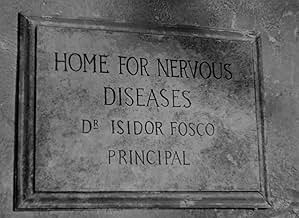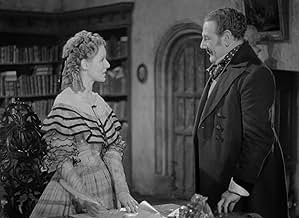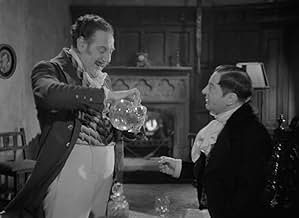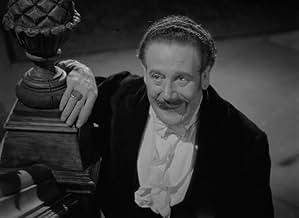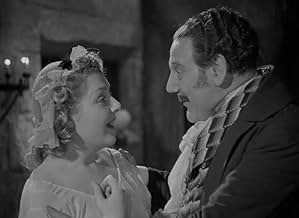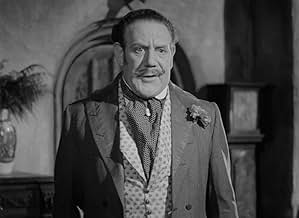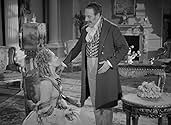Añade un argumento en tu idiomaA madman kills a man who has just inherited a large estate, then impersonates his victim to gain entrance to the estate so he can murder his enemies.A madman kills a man who has just inherited a large estate, then impersonates his victim to gain entrance to the estate so he can murder his enemies.A madman kills a man who has just inherited a large estate, then impersonates his victim to gain entrance to the estate so he can murder his enemies.
- Dirección
- Guión
- Reparto principal
Grace Arnold
- Maid
- (sin acreditar)
Vincent Holman
- Asylum Doctor
- (sin acreditar)
Reseñas destacadas
I have to admit to having never seen a Tod Slaughter movie. What a great screen presence. What an absolute cad. He is the consummate conniver and master of perversity. He kills a man in Australia and takes over his identity. He becomes the Lord of the Manor and runs the household on his own rancid terms. He gets a servant girl pregnant. He marries a local landowner's daughter and does anything to get his hands on the money available to him. There are some wonderful performances, especially that of Hay Petrie, the great sniveling character actor. He consorts with Slaughter with hopes of getting some of the money himself. There are convenient murders and acts of desperation. Through it all, Slaughter laughs at the suffering of others. There is only one person in his world.
Crimes at the Dark House is really one of my all-time favorites. Not only it's the best adaptation of Wilkie Collins' The Woman in White (by far superior to the latter Hollywood version), but it's also the more perfect of the eight films produced/directed by George King with the great Tod Slaughter. This actor being one of my favorites, I like practically all of his movies, but the fact is that Crimes at the Dark House has better production values, witty dialogue, a better mobility of the camera, and wonderful actors, including the great Hay Petrie as the sinister Count Fosco, head of an insane asylum. The film has priceless value in keeping on film the performance of Slaughter, a really unique comedian, preserving one of his better characterizations. Sure, other titles like The Face at the Window, Sweeney Todd the Demon Barber of Fleet Street, The Crimes of Stephen Hawke, and others, must have their partisans - in fact anything with Tod Slaughter is of interest, but Crimes at the Dark House is MY choice. Curiously, did anybody noticed than the print of this movie has no credited director? the British sources (magazines, books, pressbook) credit George King generally, at least a big full-page color ad of the time credits David Macdonald, but the film itself has no director credit!
It seems surprising - not knowing the copyright situation with Wilkie Collins original - that a quota quickie producer like George King should be able to get his hands on a respected literary source like THE WOMAN IN WHITE. However, the script rewrites the story so it is entirely told from the viewpoint of the false Sir Percival Glyde. Other adaptations might tell the tale from the viewpoint of the heroines as they struggle to unravel the mystery - but we are aware of the deception from the start as Tod creeps into a sleeping gold prospectors tent and dispatches him in a manner that suggests he's read Hamlet.
The disadvantage of this approach is that the fascinating, complex characters of Collins' text are flattened to one-dimensional cyphers. Laura is as much of a shrinking violet as she is in the novel but the fascinating figure of Marion (sapphic hints well suppressed here) is sidelined for much of the time. The annoyingly-hypochondriac Mr Fairlie seems more robust and more of a stock-comic figure. But the reduction of the fascinating figure of Count Fosco to Glyde's stooge is the most grievous oversight. Fosco - a roly-poly lovable eccentric who liked dogs and sunlight - was all the more chilling for being above suspicion unlike the obviously-villainous Glyde. For all that Hay Petrie brings to the part, it's just a shadow of what it could be. Still, Petrie and Slaughter make a fine pair of rogues - a cut-rate British version of Sidney Greenstreet and Peter Lorre.
What do we get in compensation for this? Two words - Tod Slaughter. His films are unique in that we get to view the story from the villain's perspective - imagine James Bond from Blofeld's viewpoint. He rises to the occasion here and is at his most lecherous - fixing his beady eyes on a comely maid whom he assigns "special duties", then strangles when she becomes inconveniently pregnant, gleefully snogging Laura upon first meeting her, and finally trying his evil way on her sister at the climax saying "I used to break precipitous horses in the Australian gold fields, and I'll enjoy breaking you!" Seldom has any villain cackled so evilly as Tod does here. Tod may start the film in an understated fashion as "Sir Percival" comes home but he's soon giving us the full melodramatic range - shifty up-to-no-good expression, comic exasperation as the bills pile up, and unashamed lechery as - convincingly sloshed on his wedding night - he ominously mounts the stairs as his squeamish bride waits fearfully in her bed. Incredibly, he is allowed to have his "wicked way" with her. Further examples of unbridled villainy include opening the window in the bedroom of the pneumonia-ridden Woman in White - having announced he expects a "change in her condition" - and luring one victim to her death saying she will, shortly, "be going on a long journey". Freddy Krueger could do with Tod's gag writers.
Something just occurred to me. We never discover the true identity of Tod's character. But examine the facts. A boozy, lecherous, overweight rogue from Australia who abuses a position of social authority and whose very repellent physical presence doesn't dampen his sex-drive for the ladies - was he Sir Les Patterson?
The disadvantage of this approach is that the fascinating, complex characters of Collins' text are flattened to one-dimensional cyphers. Laura is as much of a shrinking violet as she is in the novel but the fascinating figure of Marion (sapphic hints well suppressed here) is sidelined for much of the time. The annoyingly-hypochondriac Mr Fairlie seems more robust and more of a stock-comic figure. But the reduction of the fascinating figure of Count Fosco to Glyde's stooge is the most grievous oversight. Fosco - a roly-poly lovable eccentric who liked dogs and sunlight - was all the more chilling for being above suspicion unlike the obviously-villainous Glyde. For all that Hay Petrie brings to the part, it's just a shadow of what it could be. Still, Petrie and Slaughter make a fine pair of rogues - a cut-rate British version of Sidney Greenstreet and Peter Lorre.
What do we get in compensation for this? Two words - Tod Slaughter. His films are unique in that we get to view the story from the villain's perspective - imagine James Bond from Blofeld's viewpoint. He rises to the occasion here and is at his most lecherous - fixing his beady eyes on a comely maid whom he assigns "special duties", then strangles when she becomes inconveniently pregnant, gleefully snogging Laura upon first meeting her, and finally trying his evil way on her sister at the climax saying "I used to break precipitous horses in the Australian gold fields, and I'll enjoy breaking you!" Seldom has any villain cackled so evilly as Tod does here. Tod may start the film in an understated fashion as "Sir Percival" comes home but he's soon giving us the full melodramatic range - shifty up-to-no-good expression, comic exasperation as the bills pile up, and unashamed lechery as - convincingly sloshed on his wedding night - he ominously mounts the stairs as his squeamish bride waits fearfully in her bed. Incredibly, he is allowed to have his "wicked way" with her. Further examples of unbridled villainy include opening the window in the bedroom of the pneumonia-ridden Woman in White - having announced he expects a "change in her condition" - and luring one victim to her death saying she will, shortly, "be going on a long journey". Freddy Krueger could do with Tod's gag writers.
Something just occurred to me. We never discover the true identity of Tod's character. But examine the facts. A boozy, lecherous, overweight rogue from Australia who abuses a position of social authority and whose very repellent physical presence doesn't dampen his sex-drive for the ladies - was he Sir Les Patterson?
Now you could never describe Tod Slaughter as versatile, but as a pantomime baddie-cum-cad, you'll struggle to find someone better. Sure, his style of acting probably did lend itself better to silent films, but in this rather enjoyable drama he comes across quite mischievously. We start when he kills the real "Sir Percival" in the far-flung Australian gold fields then returns to claim his family fortune. Snag? Well what he actually inherits is £15,000 worth of debt. A massive sum at the time and so an advantageous marriage is required. Up steps "Laurie" (Sylvia Marriott). Long promised to "Sir Percival", she agrees to obey her father and go through with the marriage. Now there is a fly in the ointment for our impersonator, here. Virtually nobody remembers him after his twenty year absence except one woman who claims he fathered a child with her before he left. He denies it, as does she - but that's because she calls him out. That intrigues the local keeper of the sanatorium "Dr. Fosco" (Hay Petrie) who sees an opportunity to line his own pockets. None of this bodes well for "Laurie". Can her sister "Marian" (Hilary Eaves) and friend "Paul" (Geoffrey Wardwell) manage to save her from her increasingly lecherous, murderous, husband and his venal cohort? The poster describes this as ideal for midnight theatre on a Friday night and that's about right. There's not much jeopardy, but Slaughter overdoes it nicely as he hams up his performance towards the denouement that I was slightly disappointed with. Still, I don't suppose the baddie can ever win.... Fun, this - worth a watch.
Tod Slaughter plays(or over plays) another delightfully evil scoundrel in this British melodrama. The hard drinking and womanizing character Slaughter plays commits one evil act after another while delivering lines like "I`ll feed you`re entrails to the pigs" and "I`ll squeeze the life out of you`re greasy body". He actually gives his mustache a twirl ala Snidely Whiplash who could have been based on him. This is hardly even a B-Picture but its lots of fun.
¿Sabías que...?
- CuriosidadesVery loosely based on the 1859 novel "The Woman in White" by Wilkie Collins.
- PifiasWhen Marian Fairlie sneezes, Sir Frederick Fairlie complains about her spreading germs. But the story is set in the 1850s, and the germ theory of disease would not be known to the public until the 1870s.
- Citas
The False Percival Glyde: [after tying a noose around his victim's neck] You always said, you were a teetotaler. You're going to have a nice drop, now!
Selecciones populares
Inicia sesión para calificar y añadir a tu lista para recibir recomendaciones personalizadas
- How long is Crimes at the Dark House?Con tecnología de Alexa
Detalles
- Duración1 hora 9 minutos
- Color
- Relación de aspecto
- 1.37 : 1
Contribuir a esta página
Sugerir un cambio o añadir el contenido que falta

Principal laguna de datos
By what name was Crimes at the Dark House (1940) officially released in India in English?
Responde
